Listen, I grew up on Chickenjoy like every other Pinoy kid, and don't get me wrong – I still love it! But after perfecting this Filipino-style fried chicken recipe from my Lola's old notebook, I haven't looked at fast-food chicken the same way.
I always remember that first bite: the way the crust shatters with a crisp "crack," revealing juicy meat that's been marinated in that perfect blend of calamansi, toyo and garlic. My kids now beg for this instead of drive-thru chicken. And whenever I make it for family gatherings, my siblings fight over the last piece just like we used to do at Lola's house.
Once you master this double-dredge technique and my family's secret marinade ratio, you'll be ruined for all other fried chicken – in the best possible way.
Jump to:
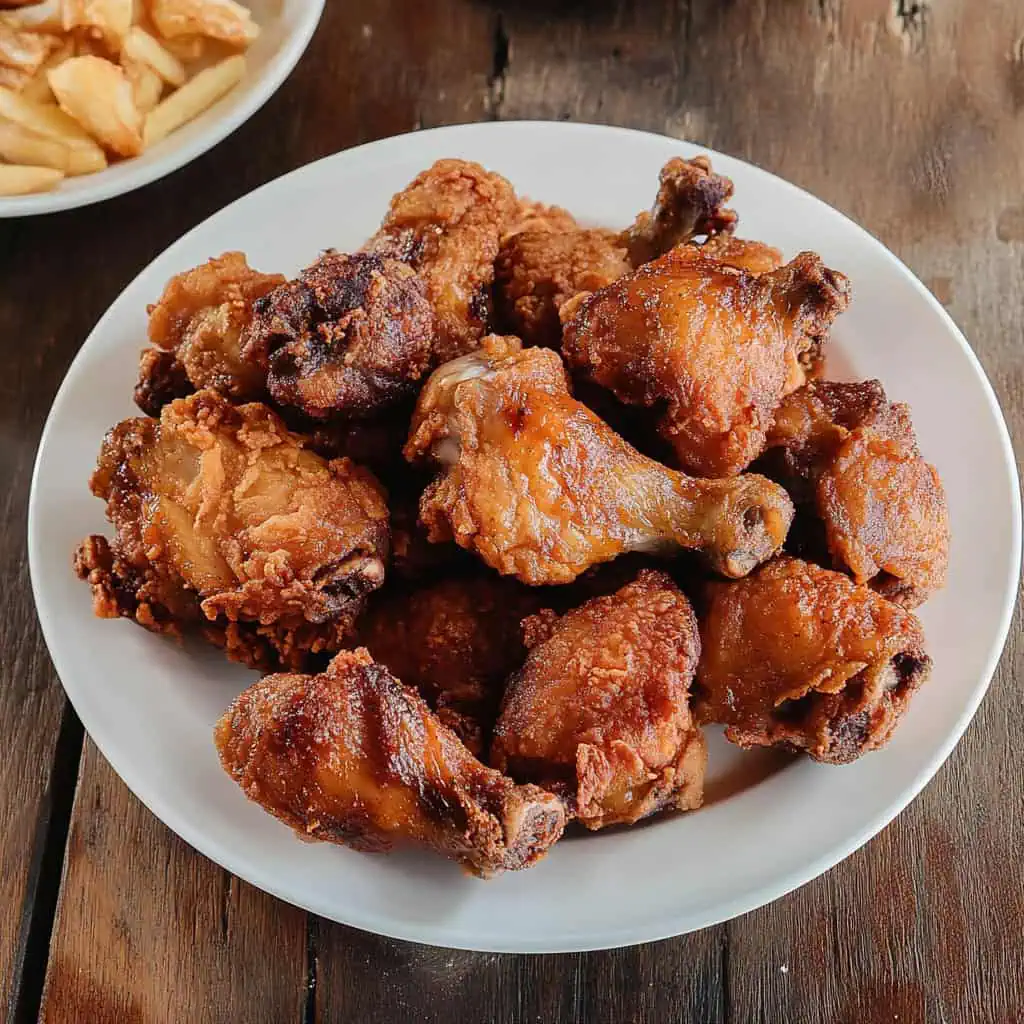
Why You'll Love This Recipe
- Perfect Crunch Factor: Achieves that coveted "crackling" sound when you bite into it
- Fully Infused Flavor: The overnight marinade ensures flavor in every bite, not just the coating
- No Special Ingredients: Uses pantry staples found in every Filipino kitchen
- Foolproof Method: Detailed temperature guidelines and visual cues for perfect results
- Family-Tested: Developed through generations of Filipino home cooking
- Versatile: Perfect for family meals, parties, or baon
Ingredients
The ingredients in this recipe create the perfect flavor balance: calamansi provides acidity to tenderize the meat while adding brightness, soy sauce delivers deep umami notes, and fresh garlic and ginger infuse aromatic complexity.
The cornstarch-flour coating mixture creates that signature light, shattering crunch that makes Filipino fried chicken distinctive from other styles, allowing the marinated flavors to shine through while maintaining a perfect crispy exterior.
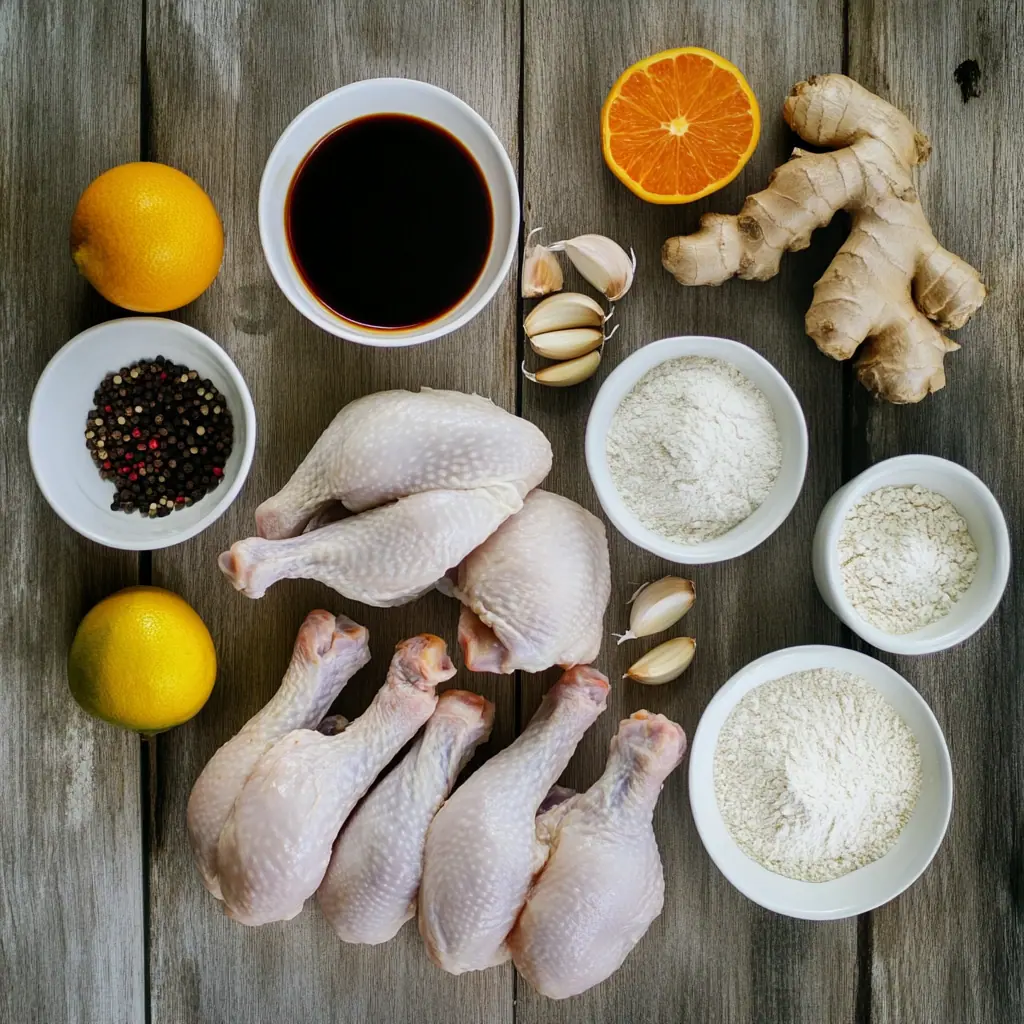
For the Marinade:
- ½ cup soy sauce
- ¼ cup calamansi juice
- 1 whole garlic head, minced
- 1 tablespoon ginger, grated
- 1 teaspoon black pepper
- 1 teaspoon salt
For the Coating:
- ½ cup all-purpose flour
- ½ cup cornstarch
- 1 teaspoon baking powder
- 1 teaspoon garlic powder
- 1 teaspoon onion powder
- 1 teaspoon salt
- ½ teaspoon black pepper
Main Ingredient:
- 3 lbs chicken pieces, preferably legs and thighs
For Frying:
- 4 cups cooking oil with high smoke point
Equipment
- Deep, heavy-bottomed pot - Provides even heat distribution for perfectly crisp chicken
- Cooking thermometer - Ensures oil reaches and maintains the ideal temperature (350-375°F)
- Wire cooling rack - Allows excess oil to drip away while keeping the chicken crisp
- Tongs - For safely turning and removing chicken from hot oil
- Large mixing bowls - For preparing marinade and coating mixture
- Shallow dish - Makes coating the chicken pieces easier
- Paper towels - For patting chicken dry before coating
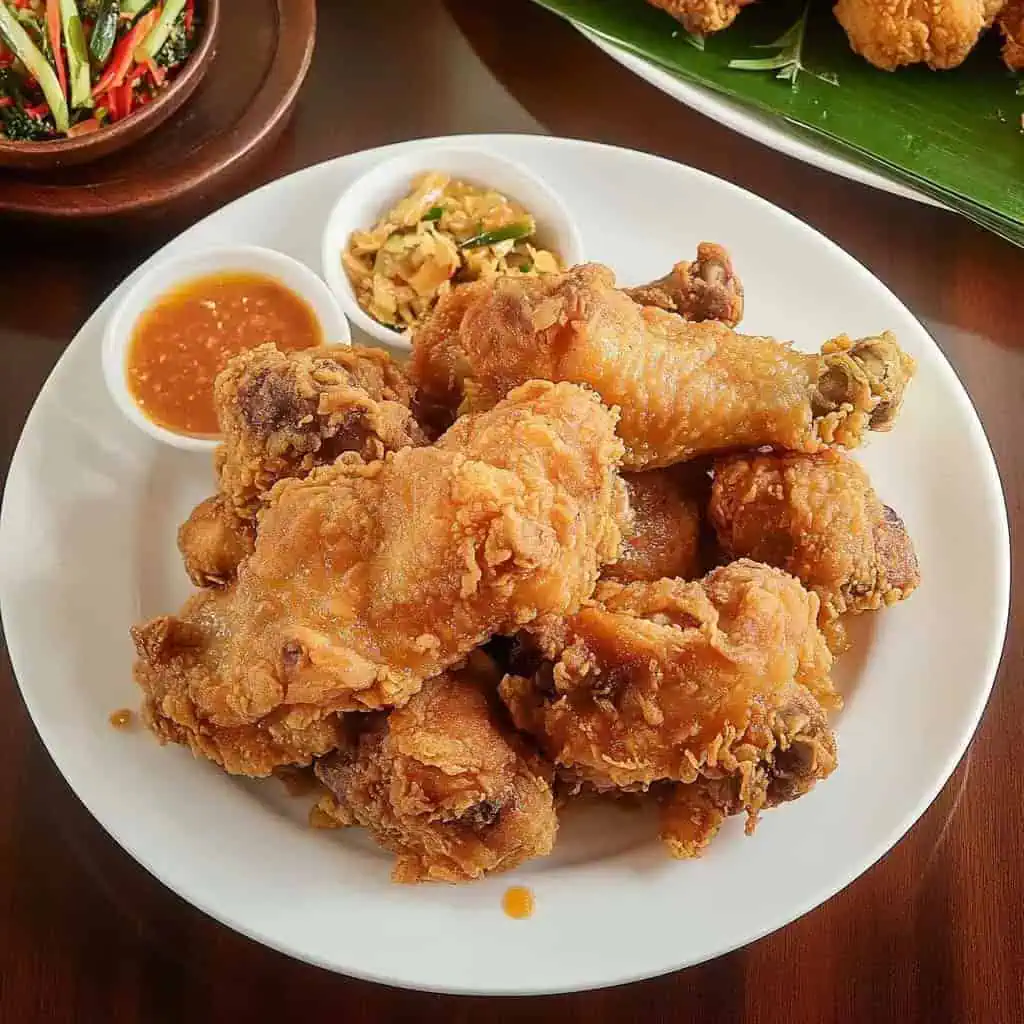
How To Make
- Prepare your marinade by combining soy sauce, calamansi juice, minced garlic, grated ginger, black pepper, and salt in a large bowl. Mix these ingredients well until the salt completely dissolves.
- Place chicken pieces in the marinade. Massage the marinade into the meat to ensure even coating. Make sure all pieces are submerged in the liquid.
- Cover the bowl and place in the refrigerator. Let the chicken marinate for at least 8 hours or overnight for best results.
- After marination, remove the chicken from the refrigerator and let it come to room temperature, about 30 minutes.
- While waiting, prepare your coating mixture. Combine the flour, cornstarch, baking powder, garlic powder, onion powder, salt, and pepper in a shallow dish. Mix thoroughly.
- Remove each piece of chicken from the marinade and pat completely dry with paper towels. This step is crucial for achieving crispy skin.
- Heat your cooking oil in a deep, heavy-bottomed pot to 350°F/175°C. Use a cooking thermometer for accuracy.
- While the oil heats, begin the double-dredging process. Take each dried chicken piece and coat thoroughly in the flour mixture, shaking off excess. Let these pieces rest for 5 minutes on a wire rack.
- After resting, dredge each piece again in the flour mixture for extra crispiness.
- Once the oil reaches temperature, carefully place the chicken pieces in the hot oil, making sure not to overcrowd the pot.
- Fry the chicken for 12-15 minutes on the first side. The coating should be turning golden brown and crispy.
- Carefully flip each piece and continue frying for another 10-12 minutes or until the internal temperature reaches 165°F/74°C.
- Remove the chicken from the oil and place on a wire rack to drain, not on paper towels. This keeps the coating crispy.
- Let the chicken rest for 5-10 minutes before serving. This allows the juices to redistribute throughout the meat.
- Serve hot with steamed white rice and your choice of banana ketchup, spiced vinegar, or toyomansi dipping sauce.

Tips from Lola's Kitchen
- Always use room temperature chicken for even cooking
- Pat chicken extremely dry before breading for the crispiest results
- Rest breaded chicken for 5-10 minutes before frying to help coating adhere
- Maintain oil temperature between 350-375°F for the perfect crunch
- Add a pinch of sugar to the marinade for better browning
- Never skip the double-dredging process - this is the secret to that perfect crust
- For extra flavor, reserve 2 tablespoons of marinade and mix into the coating mixture
Substitutions
- Calamansi juice: Lemon juice or lime juice (1:1 ratio)
- All-purpose flour: Rice flour for a gluten-free version
- Cornstarch: Potato starch will provide similar crispiness
- Canola oil: Peanut oil or vegetable oil work equally well
- Fresh garlic: Substitute with 2 teaspoons garlic powder
- Fresh ginger: Use 1 teaspoon dried ginger powder
- Chicken pieces: Chicken breast can be used but reduce marinating time to 4 hours
Troubleshooting
- Coating falls off: Ensure chicken is completely dry before breading, let the first coating rest on chicken for 5 minutes before the second dredge, and avoid moving chicken too much while frying.
- Chicken not crispy: Oil temperature may be too low, coating might be too thick or uneven, or you might not be using the double-dredge method properly.
- Outside brown but inside raw: Oil temperature is too hot, chicken pieces are too large, or you're not using a meat thermometer to check doneness.
- Chicken burning too quickly: Oil is too hot or there's too much sugar in your marinade.
- Chicken too salty: Reduce soy sauce in marinade or increase rinsing/drying time before coating.
Storage & Reheating
- Refrigerate: Store in an airtight container for up to 3 days.
- Freeze: Wrap cooled pieces individually in plastic wrap, then place in a freezer bag for up to 3 months.
- Reheating in oven: Place on a wire rack over a baking sheet and heat at 350°F for 15-20 minutes until crispy again.
- Quick reheating: Use an air fryer at 375°F for 4-5 minutes for the best texture.
- Avoid microwave reheating as it makes the coating soggy.
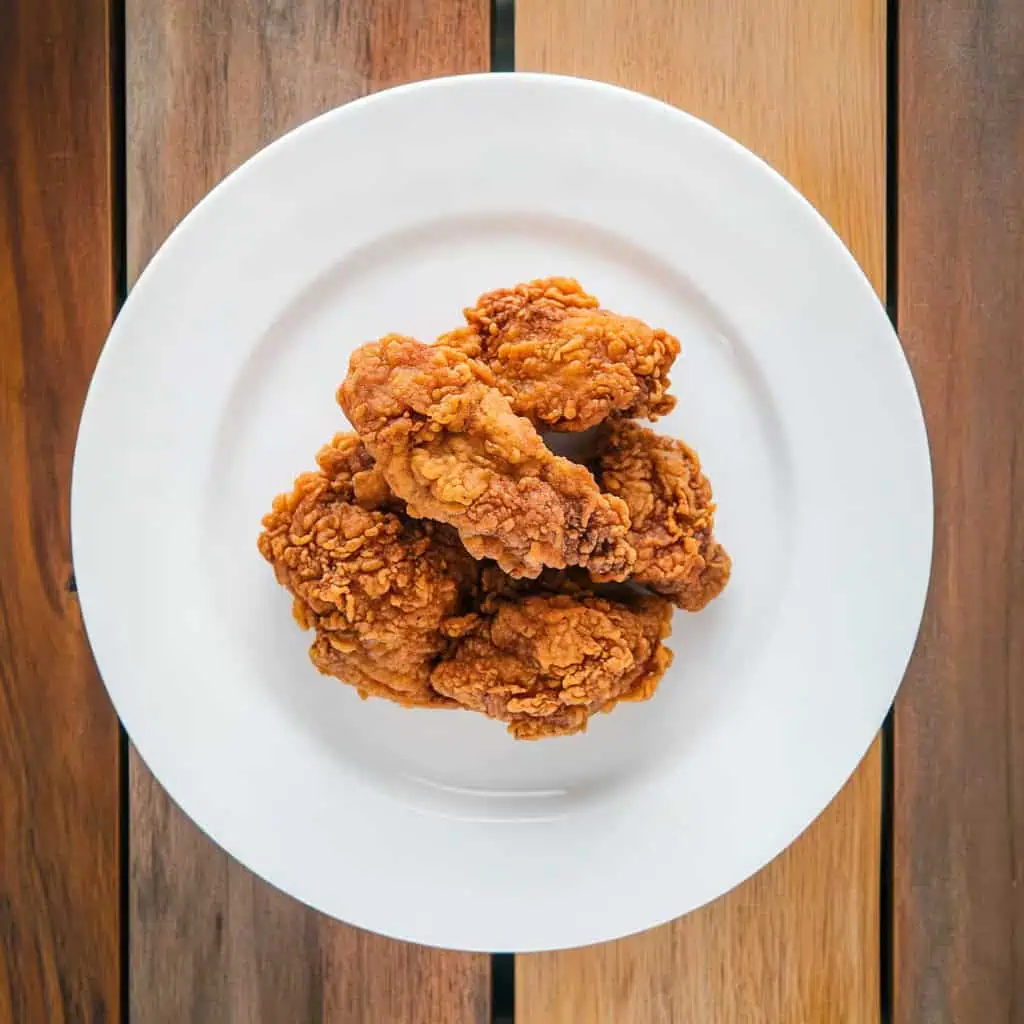
FAQ
Can I use chicken breast instead of dark meat?
Yes, but reduce marinating time to 4 hours maximum to prevent drying. Breast meat cooks faster, so adjust your frying time accordingly.
Why use cornstarch in the breading?
Cornstarch creates a crispier, lighter coating than flour alone. It also helps the coating achieve that signature "shattering" texture when you bite into it.
Can I make this ahead for a party?
Yes, you can marinate up to 24 hours ahead. For best results, coat and fry just before serving. If necessary, fry ahead, then reheat in a 350°F oven for 10-15 minutes before serving.
How do I know when the oil is at the right temperature without a thermometer?
Drop a small pinch of flour mixture into the oil. If it sizzles immediately and rises to the top, the oil is ready. If it sinks or burns quickly, adjust accordingly.
Can I air fry this chicken?
Yes, spray with oil and air fry at 400°F for 20-25 minutes, flipping halfway. The texture will be slightly different but still delicious.
Why is my chicken not as flavorful as I expected?
The marinade might not have had enough time to penetrate, or the chicken pieces might be too large. Try cutting larger pieces into smaller ones or extending the marination time.
Related
Looking for other recipes like this? Try these:
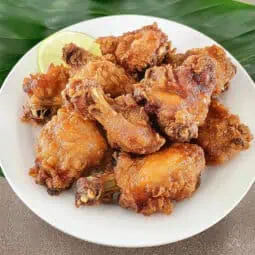
Filipino-Style Fried Chicken (Piniritong Manok)
Ingredients
For the Marinade (Para sa Pinagbabaran)
- ½ cup soy sauce toyo
- ¼ cup calamansi juice katas ng kalamansi, see alternatives below
- 1 whole garlic head minced (isang buong bawang, dinurog)
- 1 tablespoon ginger grated (luya, kinayod)
- 1 teaspoon black pepper paminta
- 1 teaspoon salt asin
For the Coating (Para sa Pambalot)
- ½ cup all-purpose flour harina
- ½ cup cornstarch cornstarch
- 1 teaspoon baking powder
- 1 teaspoon garlic powder pulbos na bawang
- 1 teaspoon onion powder pulbos na sibuyas
- 1 teaspoon salt asin
- ½ teaspoon black pepper paminta
Main Ingredient (Pangunahing Sangkap)
- 3 lbs chicken pieces preferably legs and thighs (3 pounds ng manok, mas mainam ang hita at paa)
For Frying (Para sa Pagpiprito)
- 4 cups cooking oil with high smoke point mantika
Instructions
- First prepare your marinade by combining soy sauce, calamansi juice, minced garlic, grated ginger, black pepper, and salt in a large bowl. Mix these ingredients well until the salt completely dissolves (Paghaluin ang toyo, katas ng kalamansi, dinurog na bawang, kinayod na luya, paminta, at asin sa isang malaking mangkok. Haluing mabuti hanggang matunaw ang asin).
- Take your chicken pieces and place them in the marinade. Massage the marinade into the meat to ensure even coating (Ilagay ang mga piraso ng manok sa pinagbabaran. Masahihin ang pinagbabaran sa karne para pantay ang pagkakahalo). Make sure all pieces are submerged in the liquid.
- Cover the bowl with plastic wrap or a lid and place in the refrigerator. Let the chicken marinate for at least 8 hours or overnight for best results (Takpan ang mangkok at ilagay sa refrigerator. Ibabad ng hindi bababa sa 8 oras o magdamag para sa pinakamainam na resulta).
- After marination, remove the chicken from the refrigerator and let it come to room temperature, about 30 minutes (Pagkatapos ibabad, ilabas ang manok sa refrigerator at hayaang umabot sa room temperature, mga 30 minuto).
- While waiting, prepare your coating mixture. Combine the flour, cornstarch, baking powder, garlic powder, onion powder, salt, and pepper in a shallow dish. Mix thoroughly (Ihalo ang harina, cornstarch, baking powder, pulbos na bawang, pulbos na sibuyas, asin, at paminta sa isang mababaw na pinggan. Haluing mabuti).
- Remove each piece of chicken from the marinade and pat completely dry with paper towels (Alisin ang bawat piraso ng manok sa pinagbabaran at patuyuin ng mabuti gamit ang paper towel). This step is crucial for achieving crispy skin.
- Heat your cooking oil in a deep, heavy-bottomed pot to 350°F/175°C (Initin ang mantika sa isang malalim na kawali hanggang umabot sa 350°F/175°C). Use a cooking thermometer for accuracy.
- While the oil heats, begin the double-dredging process. Take each dried chicken piece and coat thoroughly in the flour mixture, shaking off excess. Let these pieces rest for 5 minutes on a wire rack (Ibalot ang bawat pirasong manok sa harina, ipagpag ang sobra. Ipahinga ng 5 minuto sa wire rack).
- After resting, dredge each piece again in the flour mixture for extra crispiness (Ibalot muli ang bawat piraso sa harina para sa dagdag na lutong).
- Once the oil reaches temperature, carefully place the chicken pieces in the hot oil, making sure not to overcrowd the pot (Maingat na ilagay ang mga piraso ng manok sa mainit na mantika, siguraduhing hindi masyadong marami sa isang pagpiprito).
- Fry the chicken for 12-15 minutes on the first side (Iprito ang manok ng 12-15 minuto). The coating should be turning golden brown and crispy.
- Carefully flip each piece and continue frying for another 10-12 minutes or until the internal temperature reaches 165°F/74°C (Maingat na baliktarin ang bawat piraso at iprito ng 10-12 minuto pa o hanggang umabot ang loob sa 165°F/74°C).
- Remove the chicken from the oil and place on a wire rack to drain, not on paper towels (Alisin ang manok sa mantika at ilagay sa wire rack para tumulo, hindi sa paper towel). This keeps the coating crispy.
- Let the chicken rest for 5-10 minutes before serving (Ipahinga ang manok ng 5-10 minuto bago ihain). This allows the juices to redistribute throughout the meat.
- Serve hot with steamed white rice (kanin) and your choice of banana ketchup, spiced vinegar (suka), or toyomansi dipping sauce (Ihain ng mainit kasama ng kanin at banana ketchup, suka, o toyomansi sawsawan).
- For storage, let cool completely then refrigerate in an airtight container for up to 3 days (Para sa pag-iimbak, hayaang lumamig nang husto bago ilagay sa sealed container at ilagay sa refrigerator. Tatagal ito ng hanggang 3 araw).
- To reheat, place in a preheated 350°F/175°C oven for 15-20 minutes or until heated through and crispy again (Para initin muli, ilagay sa preheated na oven sa 350°F/175°C ng 15-20 minuto o hanggang mainit at malutong muli).
Tips from Lola's Kitchen
- Always use room temperature chicken for even cooking
- Pat chicken extremely dry before breading
- Rest breaded chicken for 5-10 minutes before frying
- Maintain oil temperature between 350-375°F
- Add a pinch of sugar to the marinade for better browning
- Never skip the double-dredging process
Nutrition
The Story Behind Filipino-Style Fried Chicken (Piniritong Manok)
In the vibrant tapestry of Filipino cuisine, piniritong manok (Filipino-style fried chicken) stands as a testament to our culture's remarkable ability to transform global influences into something uniquely our own. While fried chicken exists in many culinary traditions, the Filipino version tells a story of colonial history, family traditions, and our distinctive taste preferences that perfectly balance savory, tangy, and umami flavors.
The origins of Filipino fried chicken can be traced back to the American colonial period (1898-1946), when American cooking techniques began to influence local cuisine. However, Filipino cooks quickly adapted these methods, incorporating indigenous ingredients like calamansi and traditional Asian elements such as soy sauce to create something entirely new. This adaptation reflects the Filipino talent for "indigenization" – taking foreign concepts and making them unmistakably Pinoy.
What truly sets Filipino fried chicken apart is its distinctive marinade. Unlike American-style fried chicken, which often relies heavily on seasoned coating, Filipino cooks focus on infusing flavor from within. The signature combination of calamansi, toyo (soy sauce), and plenty of garlic creates a flavor profile that's instantly recognizable to any Filipino. This marinade isn't just about taste – the acid from calamansi helps tenderize the meat, while soy sauce adds depth and helps achieve that beautiful golden-brown color.
The cooking technique itself has evolved through generations of Filipino home cooks. Many families claim their own "secret" methods, passed down from their grandmothers. Some add Sprite or 7-Up to their marinades – a distinctly Filipino twist that emerged in the 1960s when soft drinks became widely available. Others insist on double-frying, a technique that creates the coveted "crack" sound when you bite into the chicken's crispy exterior.
In Filipino households, piniritong manok is more than just a dish – it's a celebration food that brings families together. Whether it's served at birthday parties (handaan), Sunday family gatherings, or packed as a special baon (packed lunch), fried chicken holds a special place in Filipino food culture. The practice of serving it with banana ketchup rather than tomato ketchup is another unique Filipino adaptation, born from the resourcefulness of our people during World War II when tomatoes were scarce.
Today's Filipino fried chicken scene perfectly demonstrates our culture's balance of tradition and innovation. While international fast-food chains like Jollibee have made Filipino-style fried chicken famous worldwide, many Filipinos still prefer their family's homestyle version. Local carinderia (small eateries) continue to serve their interpretations, each adding subtle variations that reflect regional preferences and available ingredients.
The preparation ritual itself reflects Filipino family values. The long marination time encourages planning and patience, while the actual cooking often becomes a family activity. Many Filipinos have memories of helping their mothers or grandmothers prepare fried chicken, learning through observation the small but crucial details that don't appear in written recipes – like the exact sound the oil should make when the chicken is added, or how to tell when the coating is "lutong-luto" (perfectly cooked) just by looking at its color.
Modern Filipino home cooks continue to innovate while respecting tradition. Some have adapted the recipe for air fryers, while others experiment with gluten-free coatings or healthier oils. Yet the essence remains the same – that perfect combination of crispy exterior and juicy, flavorful meat that takes us back to our childhood kitchens.
From humble family meals to proudly exported cultural icon, Filipino fried chicken represents everything wonderful about our cuisine – resourcefulness, adaptability, and the ability to create something uniquely delicious from global influences. It's a dish that tells the story of our history, celebrates our love for bold flavors, and continues to evolve while maintaining its distinctly Filipino soul.
Remember: Perfect Filipino fried chicken isn't just about crispiness—it's about achieving that ideal balance where the skin crackles perfectly while the meat remains juicy, carrying the flavors of the marinade in every bite, best enjoyed with a generous serving of hot rice and your preferred sawsawan (dipping sauce).
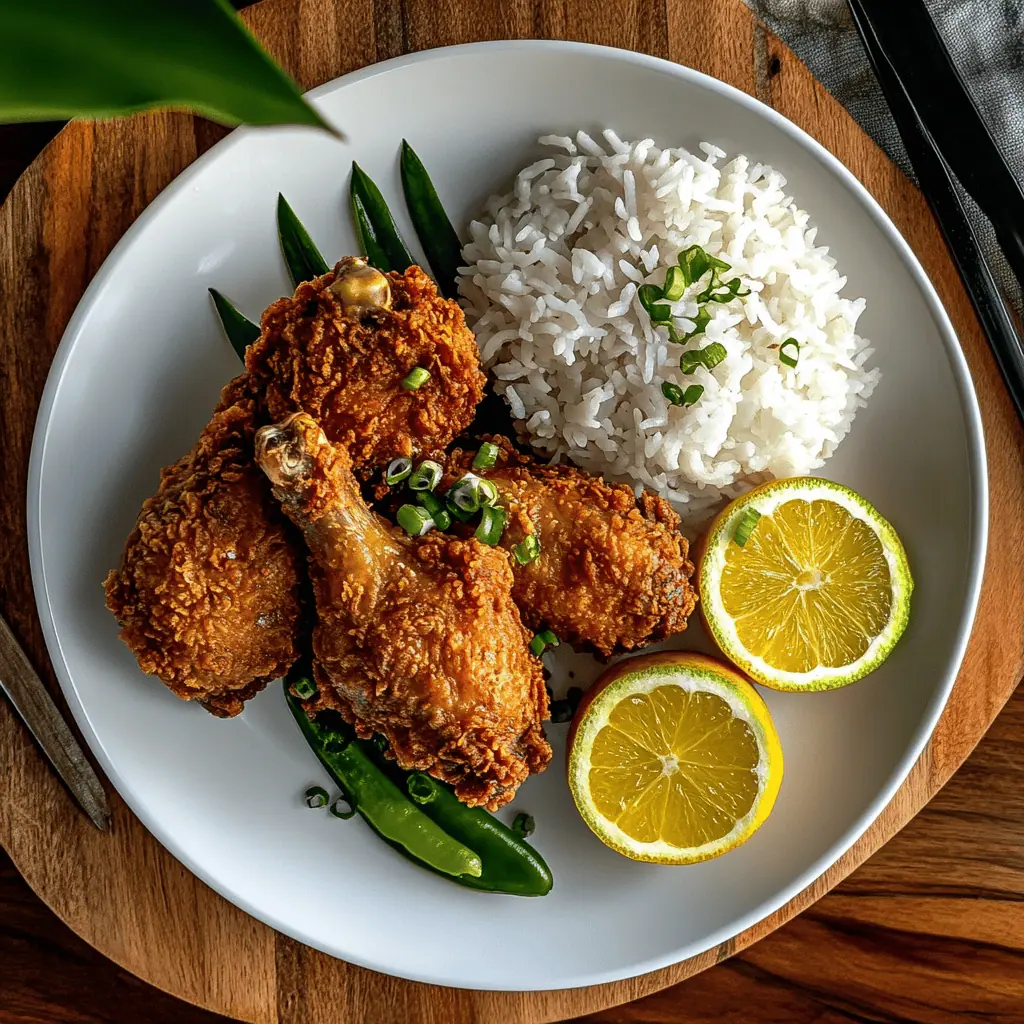









Comments
No Comments